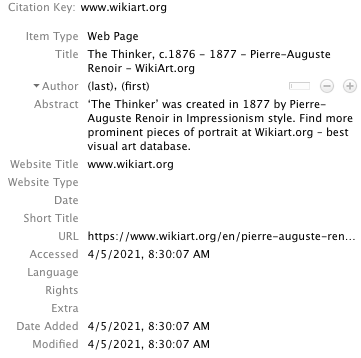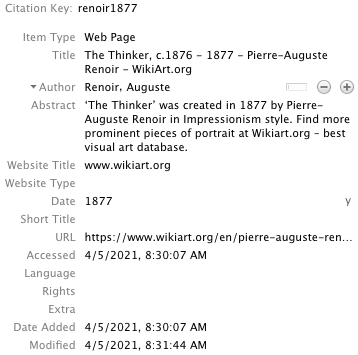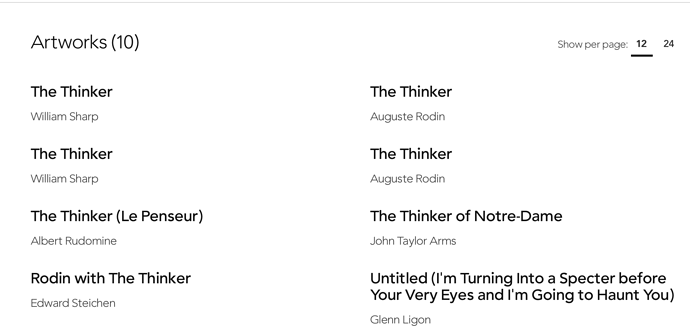By way of intro, I’m a museum guide, and have to create my own tours. I have been building my art note database for a few months now, which is wonderful in helping me build my museum tours. However, I’m feeling like I need some help with naming taxonomy.
Individual art works are the atomic unit of each note. Art works are very hard to name. Why? For each art work (which can also be architecture)… There are potentially multiple or no dates, multiple or no artists, and if an artwork is named at all, it is probably not a unique name.
Regardless of whether I use a Zettelkasten numeric prefix or not, I’d like to be able to have the remainder of the name be in some kind of standardized format, but it’s eluding me. Thoughts?
Thanks!
1 Like
How does the museum catalog them? Do you have access to that? Can you “piggy-back” their taxonomy? My instinct makes me believe that this problem has been tackled in the past by curators and administrators.
1 Like
You would think so! But it’s a mess. I am attaching an example of a search result for “The Thinker”. There are many entries that belong to this name, more than one with the same artist, and then when you go to the pages, you have a useless URL.
Here’s one: Philadelphia Museum of Art - Collections Object : The Thinker
Here’s another: Philadelphia Museum of Art - Collections Object : The Thinker
And yes, they are different works.
I wish this were easier! But alas, I’m getting no help from the museum…
That’s very frustrating.
In a data management scenario where any of the constituent key fields are possibly undefined and non-unique, I would guess the only option you have is to create a key of your own. You don’t want to wind up in a scenario where you have a prefix + 'untitled-anonymous-no-date" 10x in your files.
My approach would be to give everything an ID in a master table and then have my notes use a combination of a descriptive title+artist (when available) + that ID as a backup for when your descriptive text is not useful. That’s about the best I can think of with such an unruly dataset.
1 Like
I am running into similar problems citing videos and articles on the web, just because… well, it sucks. There’s no librarian to help, there’s the URL but not a detailed publishing record, etc.
I haven’t used it long enough to really recommend it, but I’ve been using Zotero with the browser extension and the Obsidian citation plugin. It’s nice in that it sets up just the right amount of metadata automatically for me, and then gets out of my way. And crucially, it gives a canonical name to an object of my choice, and lets me easily create a note with that canonical name.
It’s definitely still an experiment, but it takes care of a lot of manual work for me.
4 Likes
That’s an appealing idea. So how would that work for an artwork on a museum website? Would I import the link into Zotero and have it figure out how to cite it?
That’s how I imagine it? In the worst case, you have to manually wrangle some metadata on each link. It’s likely not as hands-off as one would hope.
But for me, the benefits are having a purpose-built app for storing canonical representations of “citables” with metadata – even if I have to “groom” the metadata myself – and having something else make decisions about how to build citation keys for representation in Obsidian.
1 Like
I should note that I am not producing academic works that require citations, so I want unique and canonical representations for myself, but have lower external standards for “correct” metadata.
That’s how I imagine it? In the worst case, you have to manually wrangle some metadata on each link. It’s likely not as hands-off as one would hope.
I just tried to import to Zotero, and it’s going to be a lot of manual entry for me. I don’t blame Zotero at all - whoever is responsible for database management on the museum side is not building these pages with capturing metadata in mind. But I am homing in on the idea of titling each artwork note with the syntax “[date(s)] [title] [(artist())]”. What’s nice about this is that the sort order would be chronological.
It’s a start.
Zotero has an item type for artwork: Zotero and Images - Zotero @ the WSU Libraries - LibGuides at Washington State University
I just went to wikiart’s entry for Renoir’s The Thinker and clicked the Safari Zotero browser extension button and the following entry was added to Zotero automatically:

When I added the “author” and date the cite key automatically updated:

The cite key provides a unique reference across the entire Zotero DB. If I added another item Renoir painted in 1877 the new cite key would be “renoir1877a” etc.
Note this is just me trying this out as an experiment for you, YMMV. Also I’m using the Better BibTex plugin which adds the cite key and it requires a bit of setup and config to put together.
But it does show there is a method for at least storing these in a structured way in an external tool.
Another possibility is to use YML front matter structured fields and the Dataview plugin to run searches across your files.
Ex: (note title: Renoir - The Thinker (1877), or 1877 Renoir - The Thinker or whatever)
---
artist: Auguste Renoir
title: The Thinker
year: 1877
museumVisited: Foo
whenVisited: 12/2019
---

This is why I liked it blah blah blah...
Then you can write a query perhaps like this:
table museumVisited as museum, whenVisited as visited
from ""
sort whenVisited asc
Which would generate a table containing the note name in the first column (hence my titling recommendation above) and then the museum and date visited.
There’s probably other ways as well, these are just a couple that pop out.
5 Likes
Right, and I’m in the same boat. This is only for my own notes and not for publication.
1 Like
Thanks @davecan! I have several questions, as I am brand-new to Zotero…
So when I went to install the Safari extension, there was a whole page on the Zotero site about how they don’t have the Safari extension anymore. How did you get that?
That is great if the work I am looking for is in wikiart.org, but not everything is. For example, I went to look up Marcel Duchamp’s “Bicycle Wheel”, of which Philadelphia Museum of Art has a version. The citation in wikiart.org is for a different museum, so I have to be sure of the one I am looking for (multiple copies of the same work happens a lot with either Dada or with bronzes that are made from a plaster cast).
Since I’m so new to Zotero, I have no idea what this means or how to do it.
Again, don’t know what that means. But I’m eager to learn! I know something about database manipulation, so if you point me in the right direction I can dig around.
Thanks!
That’s odd, a link to the Safari connector takes up the right half of this page: Zotero | Downloads
You can manually add a Zotero entry easily by clicking the “(+)” icon in the toolbar. Artwork is under the “More” menu in it.
BBT is a Zotero plugin that adds the citation key field, producing the unique identifier described previously. You can configure it to generate the identifier based on a lot of different fields in various ways. BBT is designed to support citations and bibliography generation in LaTeX documents but I don’t use it for that, I use it solely for the cite key support so I can use Alfred integration to hook between it and Obsidian.
Dataview is a plugin in Obsidian that provides a SQL-ish syntax for querying files using the YML front matter fields you define in those files.
Front matter: YAML front matter
Dataview plugin:
1 Like
So you are just looking for a way to consistently make “unique” numbers? libraries sometimes use cutter numbers. There are different methodologies and sources of these but it’s a way to combine letters with numbers quickly to create unique numbers. For example, in if you are cataloging a bunch of Stephen King novels, the call number which should be unique might begin KIN STE but if you wanted the titles easily ordered and unique you could use cutter which would take the first letter of the title and then add (using a chart) numbers to it.
So, for example, Stephen King’s The Shining using the LC Cutter Table would end up looking like this on the spine (using 2 cutter numbers…you can make them longer)
KIN
STE
S55
In your case, you could just choose a cutter table and apply it to title or “author” or a combo. You could even Johnny Decimal a starting number for form/media like Architecture, prints, sculpture, etc. So, say you assign sculpture 200T456 (using title Thinker).
Here’s a cool tool to get you started. Just click on LC Cutter and enter the letters in the little search box. Generally, you don’t use the whole word…just enough letters of the word to make the whole thing unique.
Ann
Thanks again! If you click on the Safari Connector link on that page, it will take you to a page that explains why there is no Safari Connector. 
Appreciate all of the resources!
Another arts/museum professional here. Wouldn’t the accession number serve to uniquely identify artworks that are otherwise titled similarly? So, in your cited case, the titles could be:
F1929-7-123 · Rodin, The Thinker
F1929-7-15 · Rodin, The Thinker
Perhaps I’m being too simple, but the accession numbers are always unique. If you’re working primarily from collection objects in Philly’s collection …
Thanks, fellow art person! I did think about using accession numbers, but the pattern for accession has changed at least twice since the beginning of the collection, so it looks weird.
The other issue is that, on occasion, I will reference an artwork in a private collection, or in the case of architecture, it’s not in a collection at all. But I see where you’re going with this…
@RFBriggs I have the new Zotero beta. It solves the problem quite well and works within the Apple security constraints.
From that page:
A beta version of the Zotero Connector for Safari 13 and up is available as part of the beta version of the Zotero app rather than as a standalone extension. After running the Zotero beta, the Zotero Connector will appear in the Extensions pane of the Safari preferences, where you’ll need to enable it.
(I came the same conclusion you did at first and was frustrated, then had to carefully read it – it’s clearly there but it feels buried in fine print lol)
Note the beta is causing a few issues with the zotero → zotfile → mdnotes → obsidian workflow (extracting PDF annotations into markdown) but that doesn’t affect what you are doing and should be cleared up soon. Just something to know if you go down that road in the very near future.
Yes - thank you! I think I got tired of reading after the first paragraph. I have installed the beta and it’s all working - great!
Hi there! I saw that the zotero option might work well, but to add an idea to this thread, I would say that you could also consider using the Wikidata system.
Of course, not all artworks are there, but it can be a powerful way to link artworks and complementary material.
For the thinker, here he is:
I would curious to know if someone uses Wikidata and Obsidian!


